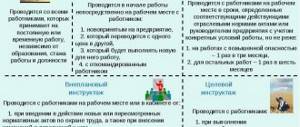According to Resolution 1/29, as well as the Labor Code of the Russian Federation, employees who are not only qualified in their field, but also able to perform their duties safely, both for themselves and for others, must be allowed to work. For some specialties, it is enough to read the relevant instructions, comply with medical requirements and can be allowed to enter the workplace. But some areas require special knowledge and preparation. The result of these procedures is the above-mentioned “crust”.
I think if I describe it in more detail, it will be more clear.
A young specialist (let’s say a roofer), after completing training and receiving the appropriate diploma (or a certificate of specialty, it doesn’t matter), is hired in his specialty to work in an organization. According to existing requirements, before he is admitted to the workplace, he must be familiarized with the organization itself (in brief, what he needs to know according to the position he holds), introduced to methods for preventing injuries and fires, and other “unpleasant moments” that arise during work (with appropriate journal entries), and, of course, obtain approval from the medical board.
BUT! This is not the end yet.
A specialist should not be allowed to enter the workplace without confirmation that he can perform his duties not only professionally, but also safely. This is exactly the kind of confirmation that is the certificate of knowledge testing (in our case of a roofer) the requirement for Labor Protection. A certificate (or, as in common parlance, “a crust”) of any working specialty, be it a welder, an installer (or other areas), is confirmation that the specialist has passed this test.
This document is issued by specialized educational institutions that have received permission in the prescribed form from the Ministry of Education (license), and from the Ministry of Labor accreditation for Occupational Safety and Health (our accreditation can be found HERE). Only after the employee has been through all the “circles of hell” (issuance of a certificate, instructions, medical examination), can he be allowed to enter the workplace.
The manager or his assistants (engineers) need this document to confirm that they can organize the production process as safely as possible for employees and the environment. Fines for employees of an organization not having the document under discussion sometimes reach up to half a million (there have been cases when managers were brought to criminal liability).
Who needs a labor protection certificate?
You need to issue occupational safety certificates:
- heads of companies and their structural divisions;
- individual entrepreneurs;
- managers of all types of work;
- OT specialists;
- employees performing hazardous work (for example, welding, operation of pressure vessels);
- representatives of labor collectives on occupational safety issues;
- persons responsible for various areas of occupational safety in departments.
Who issues occupational safety certificates?
The occupational safety certificate is issued by the organization that organized the training. It could be:
- commission of a licensed training center;
- the organization's own commission. It must include at least 3 engineers who have been trained (usually at a training center) in a given course or type of work, with valid certificates for testing knowledge of labor protection requirements.
It is often more profitable and easier for small businesses and individual entrepreneurs to undergo occupational safety training for managers and specialists at a training center and obtain a certificate than to organize such training on their own, including creating their own examination committee. You can’t just buy a labor safety certificate without completing training!
The standard validity period of a labor protection certificate is three years or more, provided that after three years retraining is completed.
Training procedure and knowledge testing
At enterprises, the procedure for conducting training is carried out in the following sequence:
- an agreement is concluded with third-party organizations that have the right to conduct training in the field of occupational safety;
- training is carried out in accordance with the local act approved by the enterprise;
- The organization may employ certified teachers if funding allows.
Employee training in the field of occupational safety is carried out in the following order:
- A list of employees who need to undergo training in certain types of activities is determined.
- A contractual relationship or a teacher in the required discipline is concluded.
- An administrative document is issued, which specifies the time and place of training, groups of workers, as well as the date of certification.
- After the study, the AK (Certification Commission) meets to take exams.
- After employees successfully pass the exams, a protocol and certificates are issued.
The certification commission consists of members and a chairman, who, in turn, must also undergo training in occupational safety courses at the educational institution.
Employee training is carried out according to programs developed at the enterprise and approved by the Ministry of Labor. Tickets for taking tests are also being developed. Currently, distance learning and taking tests are often practiced. This is very convenient, since the employee practically does not break away from work and at the same time continues to perform functional duties.
How to obtain a certificate of testing knowledge of labor protection requirements?
It is impossible to buy a labor protection certificate , because... ID numbers are registered with the territorial labor department. A new 2021 labor safety certificate is issued only after completing training at a training center or at the enterprise itself and successfully passing the exam. The training is short-term and takes approximately 1-3 days.
In the place with the labor safety certificate, the worker receives a knowledge test report or a stamped copy thereof. This document must be carefully stored. It will come in handy if the occupational safety certificate gets lost or dirty. By presenting it to the employees of the organization that conducted the training, you can easily obtain a duplicate certificate. Otherwise, you will either have to search for a long time for your name in the training protocols, which are stored in the archives of the examination commission, or undergo training again.
Sample filling
If the certificate is issued to an employee for the first time, then only the left side is filled out. If we are talking about repeated tests of knowledge, the left side is no longer filled in, all information is entered on the right. How to fill out a labor safety certificate, see below.
Fill in the left side (first time).
Step 1. We indicate the full name of the organization (indicate the abbreviated name in brackets) and assign a serial number of the certificate (we take the serial numbers from the issuing journal).
Step 2. We indicate the personal data of the employee, the name of his position and structural unit.
Step 3. We indicate which program the specialist studied in and to what extent.
Step 4. Once again, indicate the name of the organization (abbreviated) and enter the details of the minutes of the commission meeting.
Step 5. The chairman of the commission signs the certificate, indicates his last name and initials, the date and stamps the organization’s seal.
Filling the right side
You will need to proceed to filling out the right side at the next knowledge test (again).
Step 6. We record the employee’s personal data, indicating the structural unit and job title.
Step 7. Enter the details of the minutes of the commission meeting.
Step 8. The chairman of the commission signs the certificate, indicates his last name and initials, the date and stamps the organization’s seal.
Validity period of the labor protection certificate
Typically, the validity period of a labor protection certificate is 3 years or more, until the re-inspection marks expire.
This is due to the fact that the employee must undergo training and testing of knowledge of labor protection requirements every 3 years.
When this period of 3 years ends, you need to undergo training and take exams again. After a successful knowledge test, a new entry is made into the certificate, and the worker is given a corresponding copy of the protocol (or a copy thereof). Training should begin not after the expiration of the labor protection certificate, but in advance, so as not to deprive the worker of the opportunity to work.
The certificate of a labor protection specialist or employee must be renewed earlier than after 3 years if:
- the requirements of the Labor Safety Rules and other regulations on which training was conducted have changed;
- if an injury or accident occurred on the site, and the responsible persons were sent for retraining;
- During an extraordinary knowledge test, the worker showed an unsatisfactory level of knowledge. In this case, the certificate is confiscated and the employee is sent for retraining.
Why and in what cases is a certificate required?
According to Article 225 of the Labor Code of the Russian Federation, all employees, including heads of organizations, as well as employers - individual entrepreneurs, are required to undergo labor protection training.
This obligation means that each employee must undergo all types of instructions and make notes in a special journal. The knowledge gained helps to avoid death and injury at work.
Many professions and positions require the organization of special training with the subsequent issuance of a certificate, since they have special responsibilities in ensuring the safety of the work process.
The list of positions for which the presence of such a certificate is a mandatory requirement is very extensive:
- heads of organizations and enterprises;
- deputy managers;
- heads of departments;
- engineers;
- any category of employers;
- teachers teaching occupational health and safety;
- production practice managers;
- persons responsible for safety precautions;
- persons who are members of commissions investigating industrial accidents;
- specialists from executive authorities;
- and so on.
Thus, a certificate is necessary in order to engage in a certain type of activity and document one’s knowledge in the field of labor protection.
Sample of occupational safety certificate 2020
The procedure for issuing a new labor protection certificate for 2020 was approved by Resolution 1/29. Appendix 2 of the Resolution provides a sample of a labor protection certificate. Many pages can be pasted into a document. They are designed in the same way as the right side in the sample.
Completed new labor safety certificate for 2020:
Protocol attached to the labor protection certificate:
Read more: How to fill out a protocol for testing knowledge of labor protection requirements
What is better - to make forms of labor certificates yourself or to buy labor protection certificates in a printing house, store, or organization decide on their own. The main thing is that these forms are of the established form. Particular attention should be paid to the quality of the cover - it should be hard enough and reliably protect the sheets of notes. Usually its area is larger than the area of the inner sheets.
How to correctly fill out a certificate of testing knowledge of labor protection requirements?
All records are made by the responsible person of the organization that conducted the training. It is advisable that he have legible handwriting. Since there is no uniform procedure for filling out a certificate of testing knowledge of labor protection requirements, you must strictly follow the instructions printed under the lines of the sample document. So, when filling out the left side of the occupational safety certificate, enter:
- full name of the organization that provided the training;
- ID number;
- Full name, place of work, position of the worker;
- the name of the program in which the worker studied and the number of training hours spent;
- protocol details;
- current date.
After the chairman of the commission signs the occupational safety certificate, affix a stamp.
Before issuing a completed certificate of testing knowledge of labor protection requirements to a trained worker, make an appropriate entry in the certificate registration log maintained in your organization.
If the training is repeated, then the left side of the certificate is already filled out. In this case, you should fill in the right side. The procedure is the same, only the name of the organization that conducted the training and the certificate number do not need to be written. If the knowledge test was not carried out by the organization that issued the certificate, you can try to write its name in the line designated for the name of the training program. It is necessary to put a stamp every time.
After repeated knowledge tests, there is no need to re-register the document in the certificate issuance journal. If there is a need to record the renewal of certificates, you can create a separate free-form journal.
Recording the test results
First you need to fill out the minutes of the commission meeting. He will confirm that the employee, following the requirements of the law, actually attended the training, and his competencies were verified by management. A protocol must be written in any case, regardless of whether the employee passed or failed the test.
The protocol form can be taken in the same place as the occupational safety certificate form: download in Word format in Appendix No. 1 to Resolution No. 1/29. It should indicate:
- Document Number;
- name of the organization and date of compilation;
- No. of the order to conduct a knowledge test;
- FULL NAME. chairman and members of the commission;
- FULL NAME. representatives of government agencies (if present);
- name of the program and number of hours;
- list of examinees, their positions and departments;
- reasons for inspection;
- result.
The examinees put signatures opposite their names, and the chairman and members of the commission sign at the bottom of the form.










